For the second year in a row, Edmunds.com and Chief Executive Magazine have chosen the Top 10 Cars for CEOs.
To take into account both the professional and personal needs of the modern CEO, we picked the top cars for both work and play.
On the work side we set the price ceilings at $50,000, $60,000 and $75,000. The idea being that you can still get plenty of premium luxury content at these price points without incurring the kind of attention you may not want from co-workers.
See Edmunds pricing data
Has Your Car's Value Changed?
Used car values are constantly changing. Edmunds lets you track your vehicle's value over time so you can decide when to sell or trade in.

But when it comes to cars for "play," the sky remains the limit. We decided to concentrate on fun, elegance and performance. And the winners are….

1. For Work
Under $75,000
Audi A8 L
Shareholders are restless and the directors are scrutinizing your every move. That's what makes this car so right. It's built to satisfy the need for speed and the craving for comfort. Yet aside from a few of the most avid car enthusiasts, no one will know how much fun you're having driving the A8 or the even finer A8 L. We recommend it for the second year running.
Of the "Big Three" German luxury makers, only Audi has consistently delivered in terms of both exterior design and interior quality over the past five years. When it comes to high-end sedans, the A8 is saddled with none of the BMW 7 Series' controversial styling cues or the Mercedes S-Class' questionable interior materials. The car's all-wheel-drive system, paired with its adaptive air suspension and powerful 4.2-liter V8, provides a decidedly sporty feel, without any sacrifice in ride quality. It's got a six-speed transmission that could be the smoothest shifting automatic we've ever driven.
Beyond the driving dynamics is an interior that maintains Audi's tradition of world-class refinement. The leather is sublime, the metallic surfaces are made up of high-quality aluminum and steel and the MMI (Multi-Media Interface) is far more intuitive than BMW's iDrive or Mercedes' COMAND. With MMI, a driver can quickly adjust the suspension, alter the ride height, program the navigation system or adjust the audio settings.
One of the A8's most remarkable features is its price. Even a base model, at just $66,590, includes a DVD navigation system, bi-xenon headlights and a Bose stereo system with a CD changer and 12 speakers for surround sound. Options like adaptive cruise control, 19-inch wheels, XM or Sirius Satellite Radio, massaging seats and power-assist door closing can transform this Audi into a truly opulent car. Step up to the A8 L, for $74,670, and you get NBA-caliber legroom, as well as small touches such as dual-zone climate controls and lighted mirrors. Your clients and business partners will be suitably impressed.
Perhaps the best thing about an Audi is the brand perception. If you drive a Mercedes, a BMW or even a Lexus, naysayers in the workplace might say you're trying to make a statement as a successful CEO, which could come across as arrogant or tacky. Better to be understated. With no one the wiser.
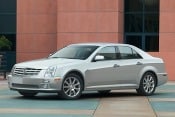
2. Under $60,000
Cadillac STS
But now comes the all-new 2005 STS, replacing the Seville, a signature vehicle of long standing. The company doesn't want to alienate a loyal purchasing base, yet it wants to reach a younger crowd.
I don't know what the snowbirds on their way to Florida might think, but the new STS sure works for me. It's built on the CTS chassis and therefore has real "throat." It also has the same smart, creased look of the CTS. Although there's still a lot of metal on the car, it's four inches wider and five inches shorter than the Seville it replaces, giving it a more muscular stance. This isn't a "floating couch," as the Seville used to be known.
And, oh, does it move. Thanks to its fully loaded V8, the car is quick off the mark, going from zero to 60 in 6 seconds. Sure, that's a full second behind, say, a Porsche, but this isn't supposed to be a Porsche.
Inside the cabin, there are many nice touches. As long as the key fob is in your pocket, you can start the car by just hitting a button. The controls are clean and uncluttered. You can actually figure out how to change the radio from FM to AM without reading an instruction manual.
In other words, this is a fully modern, impressively revamped car, but it hasn't become so enthralled with itself that it's left any of us behind.
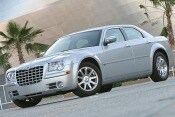
3. Under $50,000
Chrysler 300C
Once upon a time, Chrysler produced luxury cars on a par with Cadillac. Then came the dark ages of the American automobile, as long lines at the gas pump and increasing emission controls resulted in underpowered, poorly built and painfully bland "luxury" sedans.
It's taken three decades and a dramatic drop in market share, but Chrysler, like Cadillac, is once again producing premium sedans worthy of desire. Leading the charge is the all-new Chrysler 300C, a powerful retrostyled sedan that has everyone from chief executives to rappers doing a double take.
The 300C takes advantage of parent company Mercedes-Benz's technology, as the platform and suspension design are heavily influenced by Stuttgart's engineering prowess. This gives it an exceptional blend of refinement and confidence, two traits long overdue in a high-end American car.
But while the underpinnings are Euro-inspired, the exterior and drivetrain couldn't be more American. Chrysler threw in its venerable 5.7-liter Hemi engine and hooked it to the rear wheels via a Mercedes-derived, five-speed automatic transmission.
The 300C sports dual headlights, a large egg-crate grille and a high beltline that pays homage to the Chrysler 300s of the 1950s. Inside, there's plenty of head- and legroom for four full-sized adults. The interior is clean and straightforward, with upscale white-faced gauges surrounded by metallic rings.
At just over $33,000, we think the Hemi-powered 300C is an absolute bargain. Yes, the Great American Car is back, and it's better than ever.

4. For Play
Sedans
Jaguar XJ8 LWB
For nearly two decades, the Jaguar XJ-Series has possessed three undeniable characteristics: sensuous styling wrapped around limited functionality and hit-or-miss build quality. Visually, the XJ never failed to impress. But finding a comfortable seating position, and avoiding an unscheduled visit to the dealer, proved a vexing challenge. Many frustrated Jaguar buyers fled to other luxury brands.
In 2004, Jaguar redesigned the XJ8 from the ground up. Fully aware of the car's admired looks, Jaguar preserved its signature appearance. At the same time, the British automaker increased the dimensions of the XJ8, creating a roomier, more luxurious interior. The 2005 XJ8 LWB (for longer wheelbase) is larger still, earning best-in-class honors for legroom and headroom. The interior remains distinctly English. The seats are made of premium leather; the cabin is opulently accented with burl walnut.
Under the sleek hood sits a 4.2-liter V8 capable of producing 294 hp. The engine is attached to a six-speed automatic transmission that, when combined with the car's modest curb weight, active suspension and 18-inch wheels, gives the XJ8 a decidedly sporty character. Upgrading to the XJ Super 8 model boosts the engine output to 390 hp and adds a set of high-performance Brembo brakes, enhanced suspension tuning, 19-inch wheels, radar-based cruise control and a 320-watt Alpine stereo.
It's the rare automobile that can combine classic British style with 21st-century performance and luxury, but the XJ8 LWB clearly succeeds.
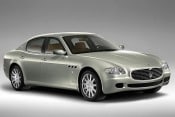
As a married man of a certain age, I seldom draw the attention of young women. So imagine my surprise when driving a Maserati Quattroporte recently. Several members of the opposite sex regarded my vehicle (and its driver) with appreciation in their eyes. Which was heart-warming, from a purely theoretical point of view, of course.
They weren't the only ones looking. Drivers of BMW 745s and other high-end vehicles were conspicuous in checking out the 2005 Quattroporte. With good reason. Ferrari, which owns Maserati, is clearly aiming at the heart of the luxury sedan market. Priced at $90,000, the Quattroporte is a bargain compared with almost all of its competitors.
Looks aside, the Quattroporte's performance is scintillating. The 4.2-liter V8 engine produces 400 horsepower, and the car is equipped with paddle shifts mounted on the steering wheel, just like Formula One racecars. When you use them to shift, it is not the plain vanilla feeling you often get with Tiptronic-style shifting. This is visceral. You don't hit the redline until nearly 8,000 rpm. And the sounds the engine feeds back are thrilling. If you prefer, you can switch over to a fully automatic mode. This car also has size: a comfortable full backseat and a trunk that easily accommodates two sets of golf clubs.
Ferrari relaunched Maserati in the United States in 2002, after a 12-year absence. Ferrari has shared some of its components and engineering with Maserati, but the two families of cars have very different personalities. Ferraris are still hell-for-leather racetrack cars, while Maseratis offer more creature comforts. If you pay $250,000 for a Ferrari, you'd almost have to join a racing club to get the most driving value for your dollar. The Quattroporte's price suggests it could be enjoyed like any other luxury sedan.
The hardest thing may be finding one to buy. The Quattroporte is sold out through the third quarter of 2005. But if you are a lover of superb sedans, the Italians have hit a sweet spot with the Quattroporte. It might be worth the extra time and effort to buy.
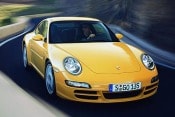
6. Sports Cars
Porsche 911 Carrera S
Believe it or not, driving a Porsche 911 Carrera S 155 mph down the German autobahn is like flying a small plane on instrument controls: safe and straightforward (although, of course, fraught with risk if your attention should lapse).
The new 911 coupe has become so thoroughly equipped with stability-enhancing countermeasures that it would take a drunk with a death wish to upset the car's equanimity. Newest of all is the optional Active Suspension Management, which uses computer-controlled, electronically valved dampers at all four corners to determine the car's most effective stance and grip, microsecond by microsecond.
The use of such driving aids is a matter of controversy among Porsche fans. It started on the previous generation of 911s with Porsche Stability Management, a sophisticated ABS/ antiskid/traction-control system that allows even novice sportsters to push the edge of the performance envelope before it modulates the throttle and selectively applies the brakes.
In terms of styling, Porsche designs cars for a market that appreciates a lack of pretension. As a result, Porsche fanatics hyperventilate over minor curves and quirks that baffle the uninitiated. This is the sixth generation of 911s, and most ordinary drivers would barely recognize the differences between the original 1964 model and the current one today. All have the same basic slope-nose, fastback, charmingly froggy look that continues to captivate serious sports car drivers.
Some felt Porsche designers went too far when in the late '90s they gave the 911 the same "face" as the entry-level Boxster, which costs half the price. Touchy 911 owners cringed every time somebody saw the distinctive headlamps shaped like badly fried eggs and said, "Nice Boxster!" The new model, thankfully, has reverted to classic oval headlights.
It is a measure of the 911's success that it has survived largely unaffected by the clamor of automotive fashion. Unlike so many marques that reinvent themselves with every fad, the 911 is a modern classic.
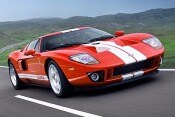
7. Ford GT
When Ford designers decided to build the GT in the spring of 2002, they were committed to creating a modern supercar worthy of the GT40 legend. Considering the accomplishments of the original, including four consecutive wins at Le Mans in the late 1960s, it seemed doubtful Ford could properly pay homage to one of the most highly regarded nameplates in auto history.
Two and half years later, the first GTs have been delivered to buyers, itself an accomplishment in terms of concept-to-production time. And the rapid development notwithstanding, Ford has managed to create an exotic car — one fully capable of humbling the best vehicles that traditional sports car marques can offer.
Ford clothed the GT with super-plastic-formed aluminum panels that pay tribute to its forebear's low-slung, muscular shape. The 5.4-liter V8 creates 550 hp, enough to catapult the GT to 60 mph in around 3.5 seconds. The car was recently certified with a top speed of 205 mph.
One interesting feature is the doorframes that wrap well into the roof, creating a challenging entry-exit process. (The design worked well for those old Le Mans-style starts where drivers had to sprint to their cars.) Inside, the GT's retro flair continues with a large, centrally located tachometer and wide gauge cluster. Dash-mounted toggle switches operate primary functions, including headlights, foglights and rear defrost, while climate controls reside on the rear part of the magnesium center console. Limited rear visibility makes parking lot maneuvers challenging to say the least, and with barely one cubic foot of cargo space you'll have to pack light.
But the GT manages to beat competitors like the Ferrari 360, the Porsche 911 GT2 and the Lamborghini Gallardo in terms of both price and performance. Throw in the 40-year racing pedigree and you're left with a modern-day American icon.
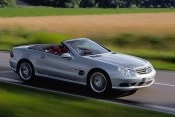
8. Convertibles
Mercedes-Benz SL600
Whenever you drive a Mercedes, there's a chance that a punk with gold chains and a cigarette dangling jauntily from his mouth will come up on your rear in a muscle car as if to say, "Come on, old man. Let's see what you got."
So when you hit the gas in the 12-cylinder Mercedes SL600, it doesn't take long before you look in your rearview mirror and the punk is gone. As in, inhaling your fumes at a distance.
OK, that might be a bit immature. But this convertible will do that to you. The lines are very clean, and the design touches around the air intakes on the hood and sides are magnificent. What's more, the Mercedes engineers have figured out a way to expand the moonroof so it encompasses almost the entire top of the car. Yet when you flick a switch, the whole top folds snugly into the trunk in mere seconds. It's the smoothest raising and lowering of a convertible top that I've experienced.
The speed of the car, meanwhile, is simply superb. The G-factors in the rear-wheel-drive SL600 make it feel like being in an airplane on takeoff, whether you're going 20 mph or 80 mph.
The only thing I could find not to like was that I sometimes inadvertently hit the cruise control lever instead of the turn signal because they're just a couple of inches apart to the left of the steering wheel.
The big questions are price and utility. The SL600 I drove was priced at $133,860. In a two-seater like this, you can't take another couple out to dinner or squeeze the kids in the back. The trunk is too small for golf clubs. And there's a limit on where you choose to drive a car this distinctive. I wouldn't drive it into the concrete jungle of New York City or leave it in a supermarket parking lot, for fear that some careless shopper would ding it.
But then again, if you can afford this car, you leave your golf bag at the club and have other vehicles for routine errands. Which means you can save the SL600 for truly peak driving experiences.

With its new 6 Series, BMW has boldly reentered the premium two-door market, producing a vehicle that is far more fun than a "personal luxury car" should be. The 645Ci convertible offers all the luxury a CEO could expect, with more performance than most will ever need.
The 4.4-liter, 325-hp engine displays the standard composure of a BMW V8, providing a broad power band and world-class refinement up to its 6,500-rpm redline. Low-end torque is abundant. There's even a throaty sound when applying the throttle — it's almost American-like in its rumble. The six-speed automatic is poised to accelerate at any speed. Hit the "sport" button and you get a more aggressive shift pattern (along with stiffer suspension and quicker throttle response).
The suspension provides both high thrills and low drama. Even at top speeds, the 645 hugs a twisting road, and it proves just as agile over broken pavement. Credit the aluminum front and rear subframes, near fifty-fifty front-to-rear weight distribution and BMW's Active Roll Stabilization. Eighteen-inch wheels are standard; opt for the sport package and you get 19-inch performance tires and an Active Steering system that adjusts steering ratio based on vehicle speed.
Peeling back the fully automated top takes less than 30 seconds and reveals an exquisite airflow design. With the side windows down, the cabin remains calm at speeds of up to 50 mph. Power the window up and the atmosphere remains placid at speeds above 75 mph. For those seeking a "sunroof effect," the 645's rear windshield can be raised, reducing the back draft effect typical of most convertibles.
At a starting price of $76,900, the 645Ci convertible isn't cheap. But the car's ability to wed upscale materials and dynamic driving pleasure in a luxurious drop-top package places it in a rarified class.
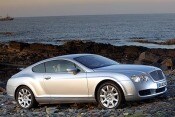
10. Coupe
Bentley Continental GT
The Bentley nameplate has undergone many changes in recent years. The company's longstanding relationship with Rolls-Royce came to an end when Volkswagen bought both brands in 1998 and subsequently ceded rights to the Rolls-Royce name to BMW last year. With Bentley now operating under the watchful eye, and generous pockets, of Volkswagen, the storied British marque is reemerging as a major player in the high-end luxury market.
The first Bentley model to fully embrace Volkswagen's technical and financial support is the Continental GT, a premium coupe that ranks as the most desirable Bentley produced in the last 80 years.
Much of the car's structure comes from the similarly compelling Audi A8, thus the active air suspension and all-wheel-drive powertrain (a first for Bentley). Each Continental GT takes over 200 worker-hours to assemble at the company's plant in Crewe, England, and the results shine through in the stunning leather and wood interior. This is not surprising when you consider Volkswagen's penchant for crafting superb interiors in models costing a fraction of the price. Real metal accents throughout the cabin highlight the old-world design elements, such as the push-pull vent controls and deep-set gauges.
Propelling the Bentley to 60 mph in less than 5 seconds is a 552-hp W12 engine, also inherited from VW and snugly positioned beneath the coupe's low hood. The Continental GT offers a six-speed automatic transmission and includes paddle shifters just ahead of the steering wheel; it can be set in a sport mode for more aggressive, fully automatic shifting or a Tiptronic mode for manual shifting via the paddles. Bentley uses an iDrive-like wheel to scroll through the car's many functions, combined with multiple buttons that allow fast access to each of the car's major systems, including climate, audio and navigation.
In many ways, the Continental GT has set a new benchmark for the premium coupe segment. Its interior quality and control layout are unsurpassed, its combination of comfort, performance and luxury unprecedented. And then there's the price, which could almost be called a bargain at $150,000.
Hot List 2005
